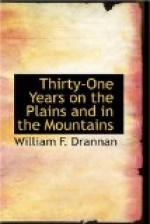At the crack of my rifle the Indians ran a few paces from me, dropped down and stuck their fingers in their ears. They told us in Spanish that they had never seen a wah-hootus before, meaning a gun with a loud report.
When Jim Beckwith went to fire his gun off, the squaws all ran away, but the bucks, being more brave, stayed, but held their hands over their ears. This tribe lived principally on fish.
The reader will remember that I had traveled over this same country in the year 1849 in company with Kit Carson and Col. Fremont, when on our trip to California.
After traveling about five miles we crossed a little sage-brush valley that was almost covered with jack-rabbits, and they were dying by the thousand. We could see twenty at one time lying dead in the sage-brush.
That night we camped on what has since been known as Beaver creek, and here we had to strike across the San Antonio desert, and having been across the desert I knew it would be eighty miles to water. Having two parafleshes with us for such emergencies, we filled them with water to use in crossing this desert.
A paraflesh is made of rawhide expressly to carry water in, and are frequently used to peddle milk by the Mexicans.
The second day from Beaver creek we reached a little stream near the Goshoot village, this being the place where Uncle Kit finished buying furs to load his pack-train in 1848.
The next morning we reached the village. I had not seen any of these Indians for five years. Then I was a mere boy and now a grown man, but every one of the Goshoots knew me and were glad to meet me. We stopped that day and visited with them, and bought some venison and frigoles, or beans.
The next morning we resumed our journey to Los Angeles, crossing the extreme northeast part of Death Valley. From here on the country was all new to me, and had it not been for the kindness of the Goshoot Indians, we would have perished for the want of water.
When I told a good Indian in that village where we were going, he sat down and with his finger marked a diagram in the dust, showing the lay of the country that we must pass ever, every little blind spring near the trail, the different mountains and valleys, and made it so plain that we could scarcely have made a mistake on the trip.
On arriving at Los Angeles we found only one white man in the place, and he was the only person in the whole town that could speak the English language. He had arrived there some years before, married a Mexican woman and had got to be very wealthy. He tried to induce us to go farther up the coast, telling us if we started for San Francisco the country was full of Mexicans, and that they despised all Americans and would be sure to murder us on our way; but as we had started for San Francisco, we were determined to see that city if possible. After laying over one day with the old American we resumed our journey.




